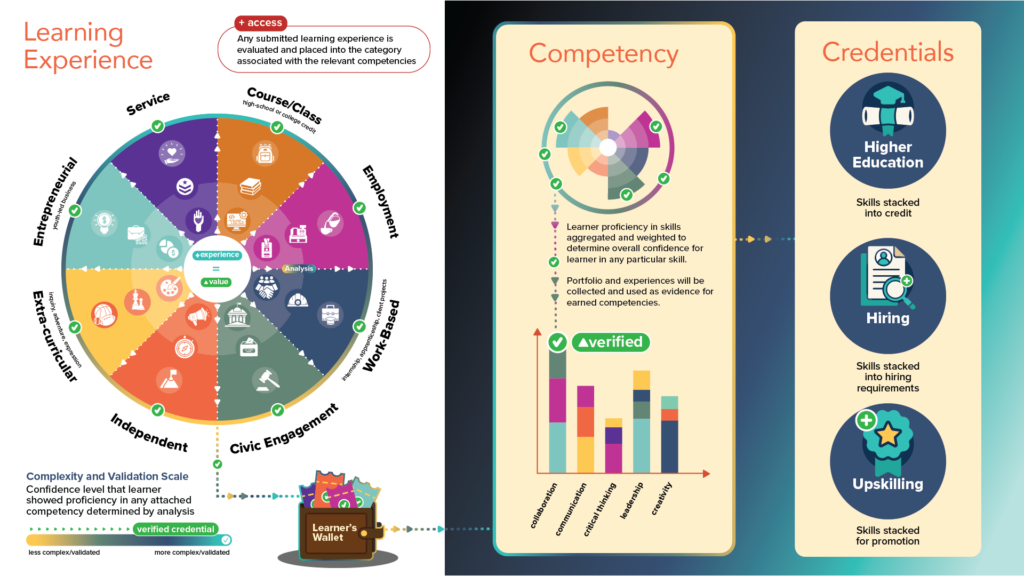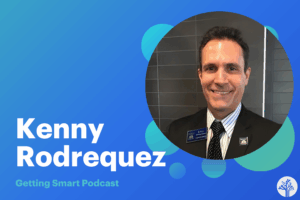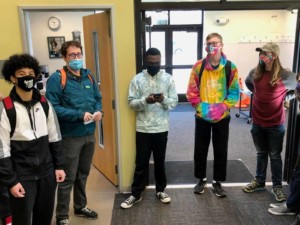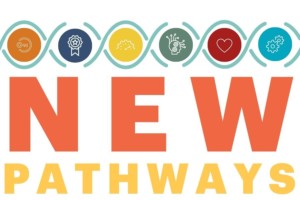We Asked A Student in 2040 What Living with An LER is Like—Here’s What She Said
Key Points
-
LERs provide a dynamic and verified way to chronicle educational and career experiences, offering a more comprehensive alternative to traditional resumes.
-
The integration of AI and digital wallets in education and employment can enhance transparency, verification, and personalization of learning and career paths.

By: Mason Pashia and Beth Ardner
These days, Learner Employment Records (LERs) are everywhere, if you know where to look. From new state-level legislation in California to radical workforce partnerships like the Alabama Talent Triad and the work being done in Wyoming and Indiana and Idaho, there’s a great deal of promise, but it can be a bit difficult to describe and even harder to imagine. What do you mean I’d have a digital wallet to capture a lifetime’s worth of experiences and skills? What’s this about self-sovereign data? When do people actually put something in their wallet? And, importantly, how do we verify this information?
AI plays (and will only continue to play) a major role in HR, admissions, documentation and data collection. Even before AI, our best approaches to resumes were well short of ideal: the average resume gets 10 seconds of attention, and, according to ResumeLab, 70% of people lie when populating their resumes. Founder of Gobekli, Danny Done, said it succinctly, “We’re using a 15th century document to run a 21st century system.” Validating and verifying these credentials, experiences, and documents builds trust, builds confidence and has the potential to strengthen ties within networks.
At the same time, LERs have been described as “a religion looking for a messiah,” —not a ringing endorsement. Essentially, funders around the world are leaning back slowly in their chairs and saying “prove it”. Proving the technology works is one thing, but showing what an LER-enabled world looks like is another. Without good evidence of growth, learning, and demonstrated competency, LER ecosystems have little heft to them. We believe that future learner wallets will be populated in the following ways:
- Self-attested stories – Something narrated and claimed by the wallet holder.
- Surveyed stories – Collected evidence from assessments and other data sources.
- Credentialed stories – This thing has a badge that’s authorized by a third party.
- Calculated stories – AI-inferred skills based on provided evidence or anecdotes.

Many people have experienced the dreaded timesheet, and few people are excited about surveillance futures, but we contribute a lot of information willingly into the ecosystem, for our own benefit. Between social media, exercise apps with leaderboards and community features, apps that track your hikes, walks, and travels, etc., we are constantly collecting evidence of experience. Whether by active means or passive means, it’s important to have transparency into the tools that recount the story of our lives.
To make all of this more tangible, here is a (fictional but possible) first-person account from Jamie, a 20-year-old in the year 2040.
An LER Ecosystem, 2040 — My View from the Inside
I’m Jamie, a second‑year student pursuing a four-year credential, and a little unsure whether I’ll stick around for the whole thing. What I am sure about is that I want real‑world security experience to make my transition into what’s next as frictionless as possible—whether that means another internship or a jump into full‑time work. In 2040, the language of opportunity is a learner‑employment record (LER) that lives in my digital wallet. Instead of a frozen snapshot like the archaic résumé, my LER is a living, verified timeline of every course, project, micro‑credential, and reflection I’ve logged since elementary school. Here are a few of the things that really helped me create a strong foundation in my wallet and LER.
8 Years Old
At the end of each school day, an avatar named “Scout” popped up on my tablet and asked me three quick questions:
- “Show me something you built or explored this week.” I’d snap a picture of my Rube Goldberg contraption.
- “Where did you feel stuck?” I’d circle the section where the marble always fell off the track.
- “What would you try next?” I’d record a 20‑second voice note.
Scout tagged the video with systems thinking, persistence, and collaboration (it noticed I kept saying “we” instead of “I”) and pushed those tags, plus my photo and voice note, straight into my LER. A teacher quickly approved the entry, adding her own note about my grit.
Two weeks later, Scout resurfaced: “You said you’d reinforce the track with cardboard. Did it work?” I uploaded proof and the skill tag iterative design leveled up by 0.3. That tiny increment, among thousands of others, followed me all the way to college.
13 Years Old
When I was 12, reflection was muscle memory. While discussing civics, we were given a “micro‑evidence” challenge: “Record a 15‑second Reel linking today’s city‑council debate to the Bill of Rights.” I hit record in the parking lot on my way to a job shadow and riffed about free speech in zoning disputes.
The prompt auto‑attached a rubric; my teacher and two peers each left reactions plus a one‑line comment. The system triangulated tone, accuracy, and confidence to assign me a civic reasoning badge.
I also had a personal dashboard that lit up if any competency went 30 days without fresh evidence. A green check meant “healthy”; yellow meant “add evidence soon”; red meant “skill atrophying—do something!” That color‑coding nudged me to keep skills current. Back in my room, I’d glance at my personal skill dashboard. Green checks meant healthy. One stubborn yellow square—creative writing—blinked at me. I submitted a recent short story I wrote for fun and joined the lit‑mag club the next day. This fresh and authentic evidence stopped the slow slide toward red.
20 Years Old, Today
I’ve come to think of my learner wallet less like a portfolio and more like a living biography. When I open it, I see a thoughtfully organized timeline of experiences—snapshots from classes, projects, internships, and challenges I’ve taken on and grown through.
There’s my freshman cybersecurity course, where I reached 92% mastery on simulations that model threats. Next to it are peer endorsements for my documentation clarity and a short video I recorded explaining some of our collaborative and preventative tactics. The next entry is from my internship at Sentinel Security. It’s filled with artifacts—badges from my supervisor for proactive risk assessment and clear client communication, including a link to our prototype we submitted for a provisional patent.
Every entry is backed by evidence and tied to outcomes, but nothing’s automatically public. I have full control over what I share and with whom. For job applications, I can toggle access for specific experiences—sometimes I’ll share a full project, other times just the reflection or final outcome. It’s not about being the most accomplished; it’s about choosing the right story for the right moment and, most importantly, for the right audience.
Matching & Applying — Navigating Opportunity
Inside the wallet lives Talent Navigator. This tool helps me navigate available opportunities for continued learning, internships, community projects, etc. I tell it that I’m looking for an internship this summer focused on cyber threats. Navigator combs boards, guilds, and social channels, then asks me through my earbuds:
Navigator: “Twelve roles found. Three are 80 % matches—want the best?”
Me: “Hit me.”
Navigator: “CipherSafe, Series B. Gap: post‑quantum crypto (4‑week upskill possible). Draft application with bias scrub?”
The Navigator flagged that I was missing formal experience in post-quantum cryptography, but it also identified a 4-week micro-course that could close that gap and suggested I add it to my learning plan.
When I clicked “apply,” it automatically generated a tailored packet: my internship project, relevant coursework, a short reflection on leading during a simulated security breach, and feedback from my peers. No generic-looking piece of paper. No guessing what they wanted to see. Just the clearest version of my work, backed by data.
One minute later, CipherSafe receives a secure link set to vanish in 30 days—and I can see how many times they click the link. Transparency is critical.
Interview & Negotiation — Owning the Narrative
I got the interview! The hiring team had already explored the parts of my LER I’d shared. Instead of walking through my experience from scratch, we focused on specifics. When they asked about working under pressure, I didn’t need to tell a story—I pulled up an anonymized (aside from myself) Slack thread from my internship where I helped triage a live issue, and they could see my decision-making unfold in real time.
After I received the offer, I returned to the Talent Navigator. It showed me where my compensation stood compared to others in similar roles and suggested that my patent filing and peer-reviewed project work might justify a higher number. I took that insight and used it to write a respectful, data-backed counteroffer. They responded the next day with an adjusted package.
Continuous Loop — Growing as I Go
Getting hired didn’t pause the learning—it deepened it. When I started at CipherSafe, a growth tracker appeared in my LER. After each sprint, I self-assess: how confident do I feel in my contributions? What did I learn? Where did I fall short? My AI coach compares those reflections with project data—pull requests, feedback cycles, team comms—and nudges me with suggestions.
When it noticed a dip in my code review frequency, it asked if I’d like to talk to a mentor. I booked the session, uploaded a reflection afterward, and that conversation became part of my leadership skill record. Small moments become momentum.
Beyond the Paycheck — Fulfillment & Flourish
The magic, though, goes beyond pay stubs. My wallet’s life domains tab tracks pursuits that feed my soul:
- A Saturday makerspace badge tallies hours mentoring girls in robotics. Each session seeds my community leadership score—and, honestly, floods me with purpose.
- Mindful Movement logs sunrise runs along the bay. Heart‑rate data merges with short reflections on clarity and stress. The wellness graph reminds me that balance is a competency, too.
- Under Creative Commons, I store short stories, short reels that I’m proud of, even short songs. Last month, an indie online publication pulled one of the reels straight from my LER, bringing with it all of the rich copyright metadata.
When any quadrant—work, wellness, community, creativity—starts blinking yellow, I feel it before burnout hits. The dashboard isn’t a nag; it’s a mirror reflecting the whole‑person I want to be.
Why It All Matters
Yes, my LER lands interviews and sweetens offers—but it also chronicles the moments of life that are the most full of learning and, well, life: rookie stories, cardboard‑buttressed marble tracks, and Saturday sparks in a girls’ robotics lab. It’s a living biography of becoming, verified and vividly mine. In a world where roles and skills mutate far faster than majors, my wallet lets me travel light while carrying everything that makes life—and work—feel brilliantly worth it.
Beth Ardner is the Vice President of Growth at Gobekli.






0 Comments
Leave a Comment
Your email address will not be published. All fields are required.